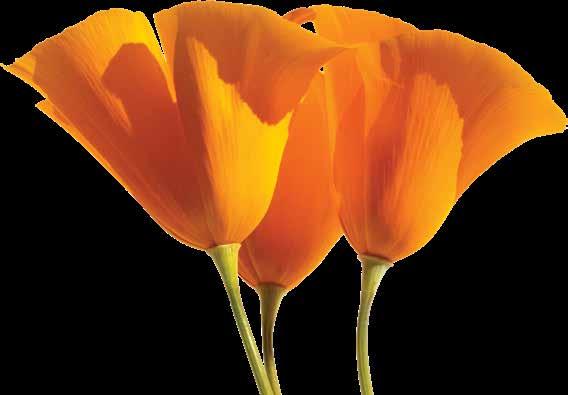
6 minute read
Desert Blooms with Art by Dyana Hesson & Faith Garvie
Desert Blooms
Advertisement
Text by Matthew B. Johnson, Program Manager and Curator | Desert Legume Program Artwork by Dyana Hesson & Faith Garvie
ARIZONA'S Sonoran Desert can appear harsh and forbidding. Yet it is a place filled with life. Months of intense heat and harsh sunlight without any rain turn the ubiquitous creosote bushes a somber brown. Many trees and shrubs lose some or all of their leaves. Saguaro cacti assume a gaunt presence. Prickly pear cactus segments become thin and may appear wilted. But these and other perennial plants, and the seeds of ephemerals are waiting for the proper conditions to return. Rainfall is the key. In years when sufficient rain falls a bewildering variety of wildflowers appear, sometimes covering the ground with carpets of color.
Unlike most dry regions, much of the Sonoran Desert has two distinct rainy seasons. One rainy season occurs during the cooler months, and the other occurs during the heat of summer. There are suites of plants that are adapted to grow and flower during one or the other of these seasons, and some that are opportunists, able to capitalize on rain whenever it might fall. Many of the long-lived perennial plants including cacti and various desert trees and shrubs will flower even in dry years. Other plants, especially ephemeral wildflowers, depend on specific timing and sufficient amounts of rain before they will germinate and flower. With adequate rainfall, there will almost always be something in flower at any time of year.
In addition to preserving many acres of rich Sonoran Desert vegetation, the Boyce Thompson Arboretum features a wide diversity of plants from dry regions across the globe. Each of these plants can add to the ever-changing tapestry of the seasonal flower show. This makes the Arboretum a premier destination to see desert plants in flower at any time of year.
If autumn rains materialize, we can be treated to a fiesta of color beginning in February or even January in mild years. Among the native plants, the bright yellow of brittlebush flowers and the delicate pink of fairy duster flowers are joined by bladderpod mustard, Mexican gold poppy, lupin, mallow, desert chia, desert chicory, and a host of other ephemeral plants that contribute to the beauty of spring wildflower displays. Perennials such as penstemon, chuparosa, larkspur, desert zinnia, paperflower, desert marigold, blue dicks, salvia, and hibiscus contribute their hues. In March the hedgehog cacti with their spectacular pink to purplish flowers are blooming, followed by prickly pear and cholla cacti in April. Late March and April are also when the palo verde trees are covered with masses of yellow flowers. Both native species, blue palo verde and foothill palo verde are considered to be the state tree of Arizona. Ocotillo produces sprays of showy orange flowers at the ends of its stems.
In late April and May, the saguaro cacti put forth their garlands of white flowers. The saguaro is the state flower of Arizona. Desert ironwood trees turn a dusty, pale pink with thousands of small, pea-like flowers in May. Various yucca species may flower from late winter into June. Among the nonnative plants, many aloes and eucalyptus flower during the cooler months along with a variety of Australian cassias and acacias. Australian bottlebrush species come in to flower in spring and can continue flowering through much of the year. By March, South American torch cacti begin to produce their magnificent flowers in an almost endless palette of colors. Red-flowered hesperaloe also begins to flower at this time and continues flowering through the end of summer.
Flowering subsides during the hot, dry weeks of June and early July. Most spring-flowering native species are ripening seeds. Winter-spring ephemerals have dried, leaving the next generation’s seeds to wait until ample rains begin the cycle anew. When the summer monsoon thunderstorms arrive, usually in July, the desert is transformed in a few days into a voluptuous riot of life as dormant plants put forth new growth and a new cast of flowers appears on stage.

“Sakes Alive, There’s Five!”
By Dyana Hesson

"Arizona Sunset with Two Cactus Blossoms"
By Dyana Hesson
The summer flowering is not as awe-inspiring as that of spring. But it provides ample opportunities to marvel at the beauty and diversity of the natural world. Common flowers include datura, summer poppy, four-o’clock, sunflower, and several morning glories. The native hibiscus species flower again, as do desert zinnia, paperflower, and desert marigold. Many shrubs flower at this time with cenizo, littleleaf cordia, lantana, bird-of-paradise, Turk’s cap, and several cassias vying for the attention of pollinators and delighting those who venture out into the heat and humidity. Texas olive, which flowers through much of the year, can be especially floriferous at this time of year.
Native cacti such as the fishhook barrel and fishhook pincushion wait for the first significant summer rain to produce their showy crowns of flowers. Even the jumping cholla, a seemingly inhospitable cactus that has a well-deserved reputation as a plant to avoid, produces delicate pink flowers through the summer heat. Many of these plants continue flowering into autumn if the monsoon is prolonged, or if the remnants of a hurricane from the tropical Pacific Ocean reaches the Sonoran Desert.
The desert is filled with endless wonders. At times these are subtle. But when the rains are generous, the desert can put forth stunning floral displays that transform the land into a lush garden of unsurpassed beauty. A visit to Boyce Thompson Arboretum at any time of year can broaden ones understanding and appreciation for the multitude of plants that have adapted to the world’s dry lands and delight the senses with their floral diversity and colors.
10 Blooms to look forward to seeing this coming monsoon season:
1. Datura 2. Summer poppy 3. Four-O'Clock 4. Morning glories 5. Sunflower 6.Littleleaf cordia 7. Lantana 8. Bird-of-paradise 9.Turks Cap 10. Fishhook Barrel

"Echinocereus triglochidiatus var. melanacanthus"
Watercolor by Faith Garvie





